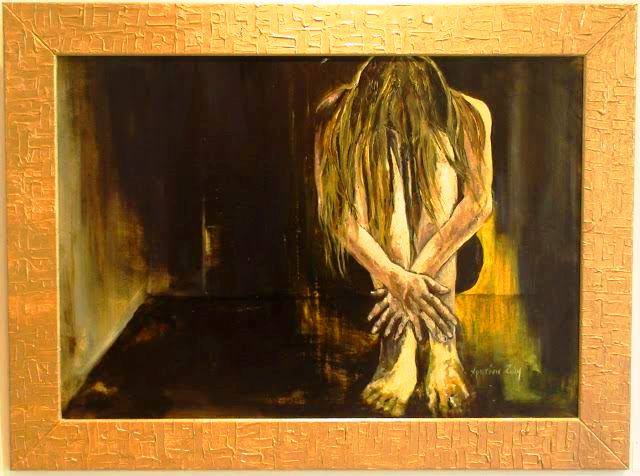“An artist is born… and I’m not talking about how he can be taught to capture volumes and mix colors. I’m talking about the talent of bringing life to a piece of blank canvas. Because the artist first creates deep in his soul and then brings his creation to light in whatever way he has chosen. It’s just like a childbirth. The idea, the image, the feeling of each day is formed within him until he feels ready to share it with the world. Christina Zoi undoubtedly has this talent. The first paintings I saw of her touched me deeply. Faces shockingly expressive dripping sea water with no painted drops. You read in their eyes the whole journey of their life, maybe even their end… In an amazing way, she captures the moments and when she feels ready to share them, she paints them, giving them duration over time. Her painting, “Love”, created mixed feelings for me and a rhetorical, rather, question troubled me: Does love involve fear… does fear involve love? Having chosen two bright colors, one warm, red and one cold, blue, I think she feels the same awe in front of him. To be afraid or to surrender to the strongest emotion that at one moment makes us fly and at the same time can furiously knock us down from the highest peak? Fear is a poor counselor. Love dares everything. Their common point is arrogance. Losing one’s mind, according to Plato. But the painter emphasizes in red, so she dares! She leaves herself to passion and this is pervasive throughout her work. She is a woman who is not afraid to live, at any cost… And while she lets himself go, she listens to the music of life that calls her to create. The eyes, the nose and the mouth are not covered by the red so all the senses are alert. Battles to win or be defeated because love is war. It is a primal cry of survival that joins everything. Which seduces, hurts, bleeds, criminalizes but remains seductive, tempting, exciting and irresistible. The battle is always lost but still we let it kill us… we let ourselves be in its music exactly as it is captured in Christina Zoi’s painting, with the treble clef replacing the ears. The moments in time are unique and unrepeatable and time is important for the painter because she says: Color is there… at the edge of time”
Evdokia Stavridou, Author (17/04/2018)
Christina Zoi is a restless painter with choices that vary between expressionism, fauvism and abstract-geometric art. Its basis is realistic. The harsh face of reality does not scares her, it inspires her and is a driving force for awakening the audience. The Fauvist extensions of her portrait painting basically follow the norm of the “traditional” representatives of the trend in question. Her artistic imprint, that is, on the one hand, in terms of colors, sometimes bears similarities to works by Matisse (La femme au chapeau, 1905), and on the other hand, in terms of texture, intensity and the thickness of the contours with works by Kees van Dongen (Femme au grand chapeau, 1906). Certainly, her canvases contain the dynamics of an evolving and promising path that can touch the neo-Fauvist forms of Kévin Bray, as they were presented in the international art magazine Numéro of the eighth issue, in July 2021. However, it is not only the portrait or the peaceful background of the still life that endow it with a continuous artistic appeal. It is also the misunderstood, by many critics, abstract. Here, the visual artist turns her gaze in two different directions at the same time: the one where geometric patterns of all kinds dominate, and the one where color dominates. In fact, sometimes these two are involved, and then any dominance, apparently, is overthrown. Admittedly, she loves, probably prefers, earth tones, and the crown of them, gold. The golden, timeless landscape has something of the majestic background of the Byzantine psi¬phidos. For Zoi, the grandiose can be found even in a wide monochrome zone, as long as you are captivated by the color and the texture, as she never refused to experiment with elements from the supremacy of the Russian avant-garde of the 1910-1930 period. Of course, as a student of Fine Arts, he did not refuse even a more elaborate decoration, which moves towards Russian Cubism. In other words, Zoe tests her ambiguous powers on abstract visuals, implying that colors and patterns in transitional times – such as the one we are going through today – should not be classified into categories with criteria of the type “black and white “, according to the old standards.
Georgios Orfanidis, Art Historian, 2023






